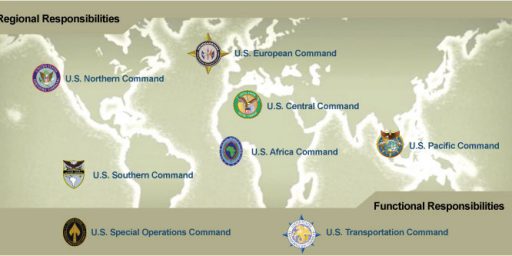SADDAM WAS DIRECTING INSURGENTS
I’m a bit skeptical of this Washington Times report:
Saddam Hussein was personally directing the postwar insurgency inside Iraq that has claimed the lives of more than 200 coalition troops, playing a far more active role than previously thought, American intelligence officers have concluded since his capture.
Despite the bewildered appearance of the deposed dictator when he was hauled from his hiding hole last weekend, he is believed to have been issuing regular instructions on targets and tactics through five trusted lieutenants.
This conclusion could have serious implications for his status in U.S. custody. U.S. officials have made clear that he will lose his rights as a prisoner of war if he was involved in the postwar violence.
Documents found in his briefcase when he was caught indicated that he had been kept informed of the progress of the insurgency, but did not suggest he had overall control of operations by former Ba’ath Party loyalists.
However, since the arrest and interrogation of guerrilla leaders identified in the paperwork, U.S. investigators now believe that Saddam was at the head of an elaborate network of rebel cells.
They have put together a detailed picture of Saddam’s support structure while in hiding. This network enabled him to issue commands without the use of satellite phones that monitoring devices could pick up.
Given the condition in which we found him, it’s a little hard to believe he was doing a whole lot other than hiding. Plus, the insurgency consists, as best we can tell, mainly of non-Iraqis who have coalesced in Iraq since the war.
This is somewhat easier to swallow:
The enablers kept Saddam informed and passed his commands to a second layer of subordinates, who headed rebel cells in such flash-point cities as Samarra and Fallujah and who passed the orders down through several tiers to the lowest-level operatives.
“He would give very general guidance like, ‘Hey, I’d like to see more attacks,’ ” the major said. “His enablers would then go out to the various tiers below them and give specific guidance, money and weapons.”
By capturing Saddam and several leaders of his Fedayeen fighters, the Americans believe that they have dealt a serious blow to the Ba’athist insurgency. Attacks on coalition forces, however, have continued since Saddam’s capture.
Issuing vague edicts every once in a while is quite different than directing the day-to-day fighting, though.




I share your skepticism, but was intrgued at the involvement they are now claiming he had. If his influence and direction were only one-third of what they’re now describing, that’s still three time MORE than I would have guessed.
Oh, yes, attacks and Coalition deaths are down this week. Which tentatively suggests that he WAS closely involved.
The next month will tell a lot.
‘Sources’ are notoriously sketchy. The only empirical data we civilians have is the events since the capture. In that time a WHOLE bunch of bad guys got rounded up quickly.
Obviously he was more in the loop than many claim.
—